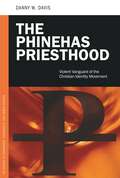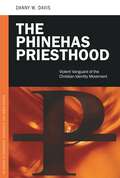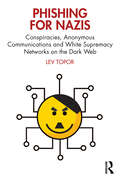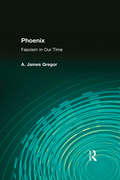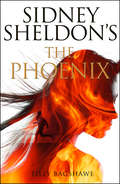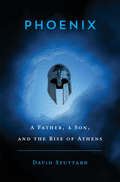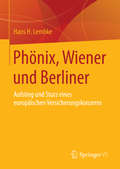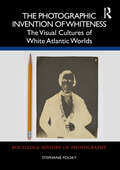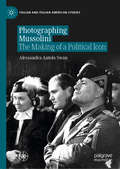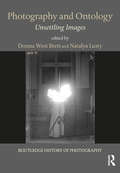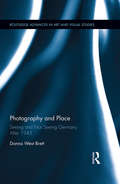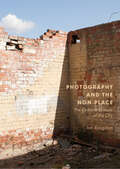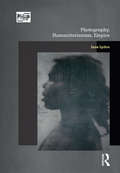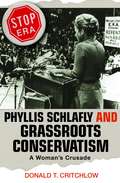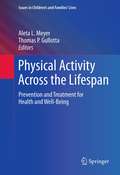- Table View
- List View
The Phinehas Priesthood: Violent Vanguard of the Christian Identity Movement (PSI Guides to Terrorists, Insurgents, and Armed Groups)
by Danny W. DavisThis book is centered on the words of leaderless resistors, men labeled as Phinehas Priests or Army of God Warriors who use force to oppose what they consider unrighteous government or ungodly laws.Positioned on America's extreme right, they are guerrilla fighters; clandestine operators who work in small cells or individually against the government and specific laws, such as those that permit abortion. Their beliefs and actions are the subject of The Phinehas Priesthood: Violent Vanguard of the Christian Identity Movement. As the book reveals, individuals who follow the Phinehas model determine that there is a higher cause, a greater good that negates all or some portion of civil law. Based on that determination, they resist perceived evil, acknowledging only the leadership of their God.The first part of this absorbing study examines organizational, resistance, and religious concepts and theories that drive these insurgents. The second part describes the beliefs, motivations, and actions of selected resistors, often using their own words to provide insights into the Christian Identity worldview and the extreme antiabortion movement. Individuals such as Walter E. Thody, Clayton Waagner, and James Kopp are quoted at length, offering firsthand perspective on the facts and events discussed.
The Phinehas Priesthood: Violent Vanguard of the Christian Identity Movement (PSI Guides to Terrorists, Insurgents, and Armed Groups)
by Danny W. DavisThis book is centered on the words of leaderless resistors, men labeled as Phinehas Priests or Army of God Warriors who use force to oppose what they consider unrighteous government or ungodly laws.Positioned on America's extreme right, they are guerrilla fighters; clandestine operators who work in small cells or individually against the government and specific laws, such as those that permit abortion. Their beliefs and actions are the subject of The Phinehas Priesthood: Violent Vanguard of the Christian Identity Movement. As the book reveals, individuals who follow the Phinehas model determine that there is a higher cause, a greater good that negates all or some portion of civil law. Based on that determination, they resist perceived evil, acknowledging only the leadership of their God.The first part of this absorbing study examines organizational, resistance, and religious concepts and theories that drive these insurgents. The second part describes the beliefs, motivations, and actions of selected resistors, often using their own words to provide insights into the Christian Identity worldview and the extreme antiabortion movement. Individuals such as Walter E. Thody, Clayton Waagner, and James Kopp are quoted at length, offering firsthand perspective on the facts and events discussed.
Phishing for Nazis: Conspiracies, Anonymous Communications and White Supremacy Networks on the Dark Web
by Lev ToporPhishing for Nazis is an evidence-based, undercover study of neo-Nazi communities on anonymous communication platforms that helps to shine a light on the dark web. It unveils how hatred and conspiracies spread and thrive online and how white supremacy is becoming prominent as extremists find shelter in the online dank underbelly of society. Phishing for Nazis explains how online manifestations of hate radicalize people into taking “real-world” action, such as shooting sprees. Methodologically, this book is unique, as it incorporates undercover cyberethnography, a method frequently used by law enforcement and intelligence agencies, unlike traditional academic studies of racism or social behavior that rely on secondary sources or surveys. With a particular interest on how race issues translate online, the book presents the true phenomenon of racism without relying on political correctness or whitewashing. It contributes to the field of cyber communication, as it details why and how people communicate and manage entire communities without knowing one another. The book also contributes to public policy, regulators, and technology companies as they deal with the practice of online anonymity and extremism.
Phishing for Nazis: Conspiracies, Anonymous Communications and White Supremacy Networks on the Dark Web
by Lev ToporPhishing for Nazis is an evidence-based, undercover study of neo-Nazi communities on anonymous communication platforms that helps to shine a light on the dark web. It unveils how hatred and conspiracies spread and thrive online and how white supremacy is becoming prominent as extremists find shelter in the online dank underbelly of society. Phishing for Nazis explains how online manifestations of hate radicalize people into taking “real-world” action, such as shooting sprees. Methodologically, this book is unique, as it incorporates undercover cyberethnography, a method frequently used by law enforcement and intelligence agencies, unlike traditional academic studies of racism or social behavior that rely on secondary sources or surveys. With a particular interest on how race issues translate online, the book presents the true phenomenon of racism without relying on political correctness or whitewashing. It contributes to the field of cyber communication, as it details why and how people communicate and manage entire communities without knowing one another. The book also contributes to public policy, regulators, and technology companies as they deal with the practice of online anonymity and extremism.
Phocion: Good Citizen in a Divided Democracy (Ancient Lives)
by Thomas R. MartinThomas R. Martin recounts the unmatched political and military career of Phocion of Athens, and his tragic downfall Phocion (402–318 BCE) won Athens’s highest public office by direct democratic election an unmatched forty-five times and was officially honored as a “Useful Citizen.” A student at Plato’s Academy, Phocion gained influence and power during a time when Athens faced multiple crises stemming from Macedonia’s emergence as an international power under Philip II and his son Alexander the Great. Following Athens’s defeat by Macedonia, Phocion unsuccessfully sought mild terms of surrender. Oligarchy was imposed on democratic Athens, and more than twelve thousand “undesirable” Athenians were exiled. When the oligarchic regime was overthrown and the exiles returned, dispossessed Athenians took out their volcanic anger on Phocion, who throughout his career had often been a harsh critic of the citizens’ political decisions. His inflammatory rhetoric contributed to the popular conclusion that he lacked a genuine sense of belonging to the community he wished so desperately to preserve. When he was eighty-four, the Athenians convicted him of treason and condemned him to die by hemlock. In this fresh biography, Thomas R. Martin explores how and why Phocion ultimately failed as a citizen and as a leader. His story offers unsetting lessons for citizens in democracies today.
Phoenix: Fascism in Our Time
by A. James GregorA great deal of effort has been expended by Anglo-American scholars in an attempt to isolate past and contemporary "fascisms", "neofascisms", "cryptofascisms" and "latent" fascisms in the modern world. A. James Gregor's "Phoenix: Fascism in Our Time" is an insightful history of the intellectual rationale for Benito Mussolini's fascism offered by major Italian intellectuals. The book provides a list of recurrent features that helps to identify the generic phenomenon. This lucid account reviews seriously neglected aspects of intellectual history, describing the socioeconomic and political conditions that precipitate and sustain fascism. Gregor shows that Italian fascism was supported by a responsible and credible rationale. His account of that rationale permits us to understand the appeal fascism as an ideal has exercised over elites and masses in the 20th century. Gregor offers a credible list of traits in showing how instances of fascism can be identified when they first appear. The last chapters of the work are devoted to a case study of the newly emergent post-Soviet Russian nationalism and its affinities with historic fascism. Gregor discusses the implications of the rise of generic fascism in the former Soviet Union and post-Maoist China. This timely volume offers an alternative to conventional interpretations of the major historical events of the 20th century. "Phoenix" is must reading for scholars and policymakers dealing with European history between the two world wars, and should will be instructive for anyone interested in the fascist ideology in a new millennium.
Phoenix: Fascism in Our Time
by A. James GregorA great deal of effort has been expended by Anglo-American scholars in an attempt to isolate past and contemporary "fascisms", "neofascisms", "cryptofascisms" and "latent" fascisms in the modern world. A. James Gregor's "Phoenix: Fascism in Our Time" is an insightful history of the intellectual rationale for Benito Mussolini's fascism offered by major Italian intellectuals. The book provides a list of recurrent features that helps to identify the generic phenomenon. This lucid account reviews seriously neglected aspects of intellectual history, describing the socioeconomic and political conditions that precipitate and sustain fascism. Gregor shows that Italian fascism was supported by a responsible and credible rationale. His account of that rationale permits us to understand the appeal fascism as an ideal has exercised over elites and masses in the 20th century. Gregor offers a credible list of traits in showing how instances of fascism can be identified when they first appear. The last chapters of the work are devoted to a case study of the newly emergent post-Soviet Russian nationalism and its affinities with historic fascism. Gregor discusses the implications of the rise of generic fascism in the former Soviet Union and post-Maoist China. This timely volume offers an alternative to conventional interpretations of the major historical events of the 20th century. "Phoenix" is must reading for scholars and policymakers dealing with European history between the two world wars, and should will be instructive for anyone interested in the fascist ideology in a new millennium.
The Phoenix
by Sidney Sheldon Tilly BagshaweThe New York Times Bestselling Author Thrilling and nail-biting, The Phoenix has all the trademark glamour, suspense and unexpected twists of a classic Sidney Sheldon novel. A deadly enemy will rise again…
Phoenix: A Father, a Son, and the Rise of Athens
by David StuttardA vivid, novelistic history of the rise of Athens from relative obscurity to the edge of its golden age, told through the lives of Miltiades and Cimon, the father and son whose defiance of Persia vaulted Athens to a leading place in the Greek world. When we think of ancient Greece we think first of Athens: its power, prestige, and revolutionary impact on art, philosophy, and politics. But on the verge of the fifth century BCE, only fifty years before its zenith, Athens was just another Greek city-state in the shadow of Sparta. It would take a catastrophe, the Persian invasions, to push Athens to the fore. In Phoenix, David Stuttard traces Athens’s rise through the lives of two men who spearheaded resistance to Persia: Miltiades, hero of the Battle of Marathon, and his son Cimon, Athens’s dominant leader before Pericles. Miltiades’s career was checkered. An Athenian provincial overlord forced into Persian vassalage, he joined a rebellion against the Persians then fled Great King Darius’s retaliation. Miltiades would later die in prison. But before that, he led Athens to victory over the invading Persians at Marathon. Cimon entered history when the Persians returned; he responded by encouraging a tactical evacuation of Athens as a prelude to decisive victory at sea. Over the next decades, while Greek city-states squabbled, Athens revitalized under Cimon’s inspired leadership. The city vaulted to the head of a powerful empire and the threshold of a golden age. Cimon proved not only an able strategist and administrator but also a peacemaker, whose policies stabilized Athens’s relationship with Sparta. The period preceding Athens’s golden age is rarely described in detail. Stuttard tells the tale with narrative power and historical acumen, recreating vividly the turbulent world of the Eastern Mediterranean in one of its most decisive periods.
Phoenix cities: The fall and rise of great industrial cities (CASE Studies on Poverty, Place and Policy)
by Anne Power Jörg Plöger'Weak market cities' across European and America, or 'core cities' as they were in their heyday, went from being 'industrial giants' dominating their national, and eventually the global, economy, to being 'devastation zones'. In a single generation three quarters of all manufacturing jobs disappeared, leaving dislocated, impoverished communities, run down city centres and a massive population exodus. So how did Europeans react? And how different was their response from America's? This book looks closely at the recovery trajectories of seven European cities from very different regions of the EU. Their dramatic decline, intense recovery efforts and actual progress on the ground underline the significance of public underpinning in times of crisis. Innovative enterprises, new-style city leadership, special neighbourhood programmes and skills development are all explored. The American experience, where cities were largely left 'to their own devices', produced a slower, more uncertain recovery trajectory. This book will provide much that is original and promising to all those wanting to understand the ground-level realities of urban change and progress.
Phönix, Wiener und Berliner: Aufstieg und Sturz eines europäischen Versicherungskonzerns
by Hans H. LembkeDer Band stellt einerseits Vorgeschichte, Verlauf und Auswirkungen eines der spektakulärsten Zusammenbrüche eines Versicherungskonzerns im 20. Jahrhundert dar und bietet darüber hinaus eine am Beispiel demonstrierte, systematische Analyse der Verflechtung von Misswirtschaft mit Medien, Staat und Gesellschaft. Die Phönix Lebensversicherung, mit Sitz in Wien und Kunden in 22 Ländern, wurde im Jahr 1936 zahlungsunfähig. Sie hatte riesige Verluste aufgetürmt, Bilanzen gefälscht und Schlüsselpersonen hofiert. Ihr Sturz drohte eine europaweite Finanzkrise auszulösen und wurde mit diktatorischen Maßnahmen aufgefangen. Das Buch schildert die wirtschaftliche wie politische Rolle des Versicherers vor 1918, während der Weimarer Republik und ab 1933.
The Photographic Invention of Whiteness: The Visual Cultures of White Atlantic Worlds (Routledge History of Photography)
by Stephanie PolskyFocusing on the creation of the concept of Whiteness, this study links early photographic imagery to the development and exploitation that were common in the colonial Atlantic World of the mid-to-late nineteenth century. With the advent of the daguerreotype in the mid-nineteenth century, White European settlers could imagine themselves as a supra-national community, where the attainment of wealth was rapidly becoming accessible through colonisation. Their dispersal throughout the colonial territories made possible the advent of a new representative type of Whiteness that eventually merged with the portrayal of modernity itself. Over time, the colonisation of the Atlantic World became synonymous with fascination itself within a European mind fixated upon both a racially subordinated world and the technical media through which it was represented. In the intervening centuries, images have acted as a medium of the imaginary, allowing for ideas around classification and the measurement of value to travel and to situate themselves as universal means. Contemporary societies still grapple with the residues of race, gender, class, and sexuality first established by the contrived mores of this representational medium, and those who were racialised by the camera as objects of fascination, curiosity, or concern have remained so well into the post-digital era. The book will be of interest to scholars working in history of photography, art history, colonialism, and critical race theory.
The Photographic Invention of Whiteness: The Visual Cultures of White Atlantic Worlds (Routledge History of Photography)
by Stephanie PolskyFocusing on the creation of the concept of Whiteness, this study links early photographic imagery to the development and exploitation that were common in the colonial Atlantic World of the mid-to-late nineteenth century. With the advent of the daguerreotype in the mid-nineteenth century, White European settlers could imagine themselves as a supra-national community, where the attainment of wealth was rapidly becoming accessible through colonisation. Their dispersal throughout the colonial territories made possible the advent of a new representative type of Whiteness that eventually merged with the portrayal of modernity itself. Over time, the colonisation of the Atlantic World became synonymous with fascination itself within a European mind fixated upon both a racially subordinated world and the technical media through which it was represented. In the intervening centuries, images have acted as a medium of the imaginary, allowing for ideas around classification and the measurement of value to travel and to situate themselves as universal means. Contemporary societies still grapple with the residues of race, gender, class, and sexuality first established by the contrived mores of this representational medium, and those who were racialised by the camera as objects of fascination, curiosity, or concern have remained so well into the post-digital era. The book will be of interest to scholars working in history of photography, art history, colonialism, and critical race theory.
Photographing Mussolini: The Making of a Political Icon (Italian and Italian American Studies)
by Alessandra Antola SwanThis pioneering book offers the first account of the work of the photographers, both official and freelance, who contributed to the forging of Mussolini's image. It departs from the practice of using photographs purely for illustration and places them instead at the centre of the analysis. Throughout the 1930s photographs of the Italian dictator Benito Mussolini were chosen with much care by the regime. They were deployed to highlight those physical traits - the piercing eyes, protruding jaw, shaved head - that were meant to evoke the Duce's strength, determination and innate sense of leadership in the mind of his contemporaries. The chapters in this volume explore the photographic image in the socio-political context of the time and shows how it was a significant contributor to the development of Italian mass culture between the two world wars.
Photographing the Liberation Struggle in Zimbabwe: Politics, Power, and the Images of Zenzo Nkobi (Routledge Studies in the Modern History of Africa)
by Lungile Augustine TshumaAfter assuming power in 1980, the Zimbabwe African National Union (ZANU) has sought to control the narrative of the struggle for liberation from colonialism, to the exclusion of other players such as the Zimbabwe African People’s Union (ZAPU). This book investigates the ways in which photographs are being used within Zimbabwe, especially on social media, to challenge the prevailing narrative and reclaim the memories of the subjugated. The book analyses the photographs produced by Zenzo Nkobi during the struggle against colonialism. Drawing on the memories of veterans from ZAPU and its military wing the Zimbabwe People’s Revolutionary Army (ZPRA), the book shows that photographs can both act as a conduit for existing narratives, and as a tool for shaping memory narratives, and evidencing ZPRA military prowess ahead of other movements.At a time when Zimbabwe is reassessing the legacy of liberation, this book offers a powerful multidisciplinary assessment for researchers across the fields of history, memory, political science, African studies, and media studies.
Photographing the Liberation Struggle in Zimbabwe: Politics, Power, and the Images of Zenzo Nkobi (Routledge Studies in the Modern History of Africa)
by Lungile Augustine TshumaAfter assuming power in 1980, the Zimbabwe African National Union (ZANU) has sought to control the narrative of the struggle for liberation from colonialism, to the exclusion of other players such as the Zimbabwe African People’s Union (ZAPU). This book investigates the ways in which photographs are being used within Zimbabwe, especially on social media, to challenge the prevailing narrative and reclaim the memories of the subjugated. The book analyses the photographs produced by Zenzo Nkobi during the struggle against colonialism. Drawing on the memories of veterans from ZAPU and its military wing the Zimbabwe People’s Revolutionary Army (ZPRA), the book shows that photographs can both act as a conduit for existing narratives, and as a tool for shaping memory narratives, and evidencing ZPRA military prowess ahead of other movements.At a time when Zimbabwe is reassessing the legacy of liberation, this book offers a powerful multidisciplinary assessment for researchers across the fields of history, memory, political science, African studies, and media studies.
Photography and Ontology: Unsettling Images (Routledge History of Photography)
by Donna West Brett Natalya LustyThis edited collection explores the complex ways in which photography is used and interpreted: as a record of evidence, as a form of communication, as a means of social and political provocation, as a mode of surveillance, as a narrative of the self, and as an art form. What makes photographic images unsettling and how do the re-uses and interpretations of photographic images unsettle the self-evident reality of the visual field? Taking up these themes, this book examines the role of photography as a revelatory medium underscored by its complex association with history, memory, experience and identity.
Photography and Ontology: Unsettling Images (Routledge History of Photography)
by Donna West Brett Natalya LustyThis edited collection explores the complex ways in which photography is used and interpreted: as a record of evidence, as a form of communication, as a means of social and political provocation, as a mode of surveillance, as a narrative of the self, and as an art form. What makes photographic images unsettling and how do the re-uses and interpretations of photographic images unsettle the self-evident reality of the visual field? Taking up these themes, this book examines the role of photography as a revelatory medium underscored by its complex association with history, memory, experience and identity.
Photography and Place: Seeing and Not Seeing Germany After 1945 (Routledge Advances in Art and Visual Studies)
by Donna West BrettAs a recording device, photography plays a unique role in how we remember places and events that happened there. This includes recording events as they happen, or recording places where something occurred before the photograph was taken, commonly referred to as aftermath photography. This book presents a theoretical and historical analysis of German photography of place after 1945. It analyses how major historical ruptures in twentieth-century Germany and associated places of trauma, memory and history affected the visual field and the circumstances of looking. These ruptures are used to generate a new reading of postwar German photography of place. The analysis includes original research on world-renowned German photographers such as Thomas Struth, Thomas Demand, Michael Schmidt, Boris Becker and Thomas Ruff as well as photographers largely unknown in the Anglophone world.
Photography and Place: Seeing and Not Seeing Germany After 1945 (Routledge Advances in Art and Visual Studies)
by Donna West BrettAs a recording device, photography plays a unique role in how we remember places and events that happened there. This includes recording events as they happen, or recording places where something occurred before the photograph was taken, commonly referred to as aftermath photography. This book presents a theoretical and historical analysis of German photography of place after 1945. It analyses how major historical ruptures in twentieth-century Germany and associated places of trauma, memory and history affected the visual field and the circumstances of looking. These ruptures are used to generate a new reading of postwar German photography of place. The analysis includes original research on world-renowned German photographers such as Thomas Struth, Thomas Demand, Michael Schmidt, Boris Becker and Thomas Ruff as well as photographers largely unknown in the Anglophone world.
Photography and the Non-Place: The Cultural Erasure of the City
by Jim BrogdenThis book presents a critical and aesthetic defence of “non-place” as an act of cultural reclamation. Through the restorative properties of photography, it re-conceptualises the cultural significance of non-place. The non-place is often referred to as “wasteland”, and is usually avoided. The sites investigated in this book are located where access and ownership are often ambiguous or in dispute; they are places of cultural forgetting. Drawing on the author’s own photographic research-led practice, as well as material from photographers such as Ed Ruscha, Joel Sternfeld and Richard Misrach, this study employs a deliberately allusive intertexuality to offer a unique insight into the contested notions surrounding landscape representation. Ultimately, it argues that the non-place has the potential to reveal a version of England that raises questions about identity, loss, memory, landscape valorisation, and, perhaps most importantly, how we are to arrive at a more meaningful place.
Photography, Humanitarianism, Empire (Photography, History: History, Photography)
by Jane LydonWith their power to create a sense of proximity and empathy, photographs have long been a crucial means of exchanging ideas between people across the globe; this book explores the role of photography in shaping ideas about race and difference from the 1840s to the 1948 Declaration of Human Rights. Focusing on Australian experience in a global context, a rich selection of case studies – drawing on a range of visual genres, from portraiture to ethnographic to scientific photographs – show how photographic encounters between Aboriginals, missionaries, scientists, photographers and writers fuelled international debates about morality, law, politics and human rights.Drawing on new archival research, Photography, Humanitarianism, Empire is essential reading for students and scholars of race, visuality and the histories of empire and human rights.
Photography, Humanitarianism, Empire (Photography, History: History, Photography)
by Jane LydonWith their power to create a sense of proximity and empathy, photographs have long been a crucial means of exchanging ideas between people across the globe; this book explores the role of photography in shaping ideas about race and difference from the 1840s to the 1948 Declaration of Human Rights. Focusing on Australian experience in a global context, a rich selection of case studies – drawing on a range of visual genres, from portraiture to ethnographic to scientific photographs – show how photographic encounters between Aboriginals, missionaries, scientists, photographers and writers fuelled international debates about morality, law, politics and human rights.Drawing on new archival research, Photography, Humanitarianism, Empire is essential reading for students and scholars of race, visuality and the histories of empire and human rights.
Phyllis Schlafly and Grassroots Conservatism: A Woman's Crusade (PDF) (Politics and Society in Modern America)
by Donald T. CritchlowLongtime activist, author, and antifeminist leader Phyllis Schlafly is for many the symbol of the conservative movement in America. In this provocative new book, historian Donald T. Critchlow sheds new light on Schlafly's life and on the unappreciated role her grassroots activism played in transforming America's political landscape. Based on exclusive and unrestricted access to Schlafly's papers as well as sixty other archival collections, the book reveals for the first time the inside story of this Missouri-born mother of six who became one of the most controversial forces in modern political history. It takes us from Schlafly's political beginnings in the Republican Right after the World War II through her years as an anticommunist crusader to her more recent efforts to thwart same-sex marriage and stem the flow of illegal immigrants. Schlafly's political career took off after her book A Choice Not an Echo helped secure Barry Goldwater's nomination. With sales of more than 3 million copies, the book established her as a national voice within the conservative movement. But it was Schlafly's bid to defeat the Equal Rights Amendment that gained her a grassroots following. Her anti-ERA crusade attracted hundreds of thousands of women into the conservative fold and earned her a name as feminism's most ardent opponent. In the 1970s, Schlafly founded the Eagle Forum, a Washington-based conservative policy organization that today claims a membership of 50,000 women. Filled with fresh insights into these and other initiatives, Phyllis Schlafly and Grassroots Conservatism provides a telling profile of one of the most influential activists in recent history. Sure to invite spirited debate, it casts new light on a major shift in American politics, the emergence of the Republican Right.
Physical Activity Across the Lifespan: Prevention and Treatment for Health and Well-Being (Issues in Children's and Families' Lives #12)
by Aleta L. Meyer and Thomas P. GullottaThe statistics are disturbing: steadily rising numbers of sedentary overweight children and obese teens, and a generation looking at a shorter life expectancy than their parents’. But while it may be obvious that physical fitness benefits both the mind and body, a growing research base is supplying evidence of why this is so, and how these benefits may be reproduced in greater numbers.Physical Activity Across the Lifespan makes a clear, scientific case for exercise, sports, and an active lifestyle in preventing illness and establishing lifetime health habits at both the individual and the population levels. The book focuses on key aspects of physical/mental well-being—weight, mood, and self-regulation—and the role of physical activity in public health and school-based interventions targeting these areas. Contributors review definitional and measurement issues salient to understanding what physical activity is, to analyzing benefits of participation, and to implementing effective interventions. Also addressed are limitations of current research, steps needed to continue building the field, and emerging therapeutic possibilities for activity, such as the role of rough and tumble play in preventing ADHD. Included in the coverage:Physical activity, cognition, and school performance.The influence of social and built environments on physical activity in middle-aged and older adults.Preventing and treating obesity through physical activity.Physical activity in preventing drug use and treating chemical dependence.Antidepressant properties of physical activity.Schools as a foundation for physical activity and an active lifestyle.Physical activity as an adjunct or booster to existing interventions.Physical Activity Across the Lifespan is an innovative text for researchers and practitioners in various disciplines including health promotion/disease prevention, child and school psychology, education, health psychology, and public health, as well as program developers and policymakers in these areas.
